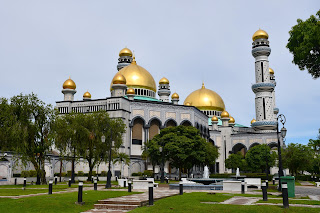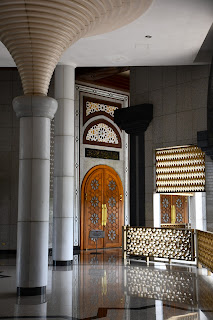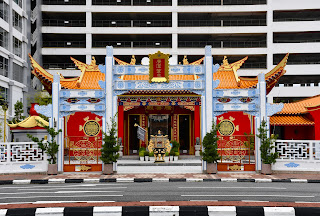Bouncing by Brunei – Day 1: Bandar Seri Begawan
Planning a weekend trip to Bandar Seri Begawan from Bangkok is not easy. As far as I can tell, the only direct flights are operated by Royal Brunei, the island country’s national carrier. While the airline schedules four flights a week, the timing around the weekend is a bit awkward, as the plane flies in on Saturday afternoon and departs on Sunday evening, leaving a visitor less than 24 hours to explore. That being the case, I decided to fly to Brunei through Malaysia: I arrived on Friday evening, stayed at an airport hotel, and left for Bandar Seri Begawan early next morning.
In
hindsight, this was not a bad plan (and certainly not a worse plan than just
sucking it up and rushing through Brunei), but it did have some drawbacks.
Firstly, Kuala Lumpur is home to one of the most pointlessly stupid airports in
the modern world. Despite being right next to each other, Terminal 1 and
Terminal 2 are functionally separate entities, as one has to pass through
customs to get from one to the other. This is particularly annoying for people
who need to transfer between them or want to stay at a hotel in one of them
after arriving at the other, which was unfortunately my case. Also, the train
between the two terminals charges money, which is quite unusual as far as
airports are concerned. Sure, it is just a symbolic sum, but what it symbolised
to me after waiting at customs for twenty minutes was a middle finger.
Another
stupid thing about Kuala Lumpur International Airport is its confusing and
often insufficient signage. I lost a few minutes of valuable sleeping time
second-guessing myself about where to go every time I could not see the next
sign, which happened frequently. I could go on, but I will end the tangential
rant here, as I cannot blame the airport for the horrible weather we got. A
strong storm forced the pilot to abruptly abort his first attempt to land just
a short distance above the ground. He managed to do it the second time round,
but landed at the wrong terminal, so we had to wait for a while until the plane
was allowed to taxi to its original slot.
I arrived
in Brunei at around nine o’clock the following morning and passed through
customs without any delay, as I had dutifully filled in my arrival form two
days in advance. As soon as I exited the airport, however, I ran into my first
problem of the day: Grab (Southeast Asia’s trusty rideshare app) was not
working. It had never occurred to me that the app’s coverage might not extend
to Brunei, as it works in both Malaysia and Indonesia. However, a quick Google
search revealed that the only rideshare app operating in Brunei is Dart.
The design
of Dart’s user interface is quite endearing: being a home-grown app, it proudly
displays the country’s colours, with its home-screen icon consisting of two
interlocking triangles (one black and one white) on a yellow background. The
drawback of being a home-grown app in such a small country, however, is that
such apps are usually garbage. After using my precious data to download Dart, I
found out it has no pickup points at the entrance to the airport. Instead, it offered
me a link to a YouTube video that promised to show me the way to the closest
pick-up point. As the set-up of my previous sentence foreshadows, it did not
show me the way, and I had to book a taxi instead.
Of course,
I do not blame Dart for being unable to procure a pick-up spot at the airport
exit; I imagine this might be due to government regulations. I do, however,
blame it for its useless instructional videos and silly quirks. The in-app map,
for example, follows the driver, so when you need to zoom out or find your own
location on the app, you can only do so for a fraction of a second. Also, instead
of showing an icon of the car like Grab does, Dart describes it in terms of
make and colour. And while I can recognise colours, I cannot for the life of me
tell the difference between an Audi, a Toyota, and a Citroen, let alone their
respective models.
My first
stop in Brunei was the Jame’ Asr Hassanil Bolkiah Mosque. One of Brunei’s two
state mosques, it was inaugurated in 1994 and carries the name of the country’s
reigning monarch. The building is notable for its two golden domes, the larger
of which forms the mosque proper and is surrounded by four minarets. The
buildings carrying each dome are octagonal and are separated by a large
ablution room, with the woodcarvings on the ground floor displaying Middle
Eastern influences. From there, an asymmetric staircase winds its way up to the
prayer room on the first floor, overlooked by a ceiling of stained glass.
Managing to
call myself a Dart taxi after all, I proceeded to the Royal Regalia Museum. The
place was recommended to me by a friend who had been to Brunei a few years ago,
and with good reason: it is surreal. Even before allowing visitors to enter,
the venue sets the mood by requiring them to take off their shoes and leave
them in the lockers outside. Only with unclad feet can one show proper
reverence to the sultan, whose portraits, belongings, and state gifts are
meticulously displayed on multiple floors of the building. Other halls use
props and headless mannequins to recreate the pompous celebrations of the
sultan’s rule, namely his enthronement and jubilees. I found that the two hands
on Brunei’s flag, which are meant to symbolise the benevolence of the
government, bear a striking resemblance to the arm used to support the king’s
head during his coronation.
Walking on
from the museum, it dawned on me that Brunei is very different from any other
country I have visited in Southeast Asia. The weather stayed relatively cool
and windy during my time there, the streets were quiet and hauntingly empty,
and the drivers would stop to let me cross the road. Still, the place did not
embody the fabulously wealthy petrostate I had imagined it to be. The cars I
saw did not seem particularly expensive, there were no luxurious shops lining
the central avenues, and the food courts looked positively socialist with their
austere seating arrangements and unglamorous decorations.
Before
carrying on to the river, I made a brief detour past Taman Haji Sir Muda Omar
Ali Saifuddien Park, the Raja Ayang Mausoleum, the Chinese Teng Yun Temple, and
Kianggeh Market. I was hoping to find lunch at the last of these, but most of
the vendors only sold fruit. Searching for vegetarian food became quite a
challenge, as all the cooks I approached at the nearby food court told me they
could not make anything without meat. Eventually, I got lucky at a Chinese
diner, where my request prompted a lot of mirth but met with an obliging
response.
The city’s
waterfront is, at least in the very centre, an elevated platform with stairs
leading all the way down to the occasional quay. Directly opposite this
platform lies Kampong Ayer, the capital’s Water Village Settlement, and a
little farther stands the Raja Isteri Pengiran Anak Hajah Saleha Bridge. Taking
pictures from the platform, I attracted the attention of a ferryman, who called
out to ask whether I would like to take a boat ride along the river. I
initially refused and only asked him to take me across. As I headed to the
steps, however, I noticed the roof of the royal palace over to the west, which
persuaded me to change my mind.
For ten
dollars (instead of the paltry single dollar to ferry me across), the ferryman
drove me down the river and closer to the palace. Except for very special
occasions, this building remains closed to visitors, and the river offers the
best views of its golden dome. The ferryman went above and beyond his
assignment, taking me past the river bend to let me see the palace from behind,
and to show me another, more European-style palace perched atop a nearby hill. The
ferryman said this palace had been built by the sultan for his second wife, but
I cannot confirm this information. Brunei’s English-speaking online community
has been heatedly (and disapprovingly) discussing the ownership of the palace,
but as far as I can tell no one has offered a definitive answer.
The
ferryman left me by the jetty closest to Kampong Ayer’s visitor centre. We had
passed by many jetties on the way there: they are numbered and follow a simple,
uniform design. Above boardwalk-level, they are mostly made of wood, with four
pillars carrying a two-sloped roof. However, the base of each jetty appears to
be made of cement and has a cement staircase leading all the way to the water. I
am told that some new government-built houses have a cement platform under the steps,
which can attract crocodiles.
Kampong
Ayer comprises hundreds of stilt houses and estimates put its population at
around ten thousand. Some of the buildings, like the public school and visitor
centre, are big government-built structures made of durable materials, but most
of the homes are wooden. A network of creaky boardwalks links the entire
settlement, with plastic pipes occasionally intersecting the pathways. The
city’s sewage system does extend to the newer houses, but older buildings still
flush their refuse straight into the river. This is why travellers wince when they
get splashed with water, and some wash their faces as soon as they return home.
Occasionally, one can see big, blue, blocklike vessels traversing the river:
these are Brunei’s mobile garbage collectors, which try to keep plastic from
completely plastering the mangroves farther downstream.
I wound my
way through the settlement until I reached the golden-domed Al-Muhtadee Billah
Mosque on the opposite bank. As I stood on Jetty Number Four waiting for a
speedboat taxi to zoom past, I knocked my lens cap onto the planks. Before I
could even think about diving to the ground to catch it, it bounced away and
made a dreadful plop into the water. Unable to properly mourn my sudden loss in
such an indecorous place, I could do little beside covering my lens with a
tissue and catching a speedboat to the other side. A few minutes later, it
occurred to me that a sock would work just as well, and I would not have to
hold my hand over my lens to keep it in place.
My last
stop for the day was Brunei’s iconic Omar Ali Saifuddien Mosque, which stands
above a crescent-shaped artificial lake. Sharing the limelight with the sight
is the stone Royal Barge, and the two can be viewed together from the park
opposite. Having thus ticked off the last item on my checklist for the day, I
decided to set off on a quest to find a spare lens cap. I was not very hopeful
and after my half-an-hour-long walk to a nearby electronics store, I was told
that I would be hard-pressed to procure such an item in Brunei. On the way, I
passed by Istana Darussalam, the former residence of Brunei’s sultans. Standing
on stilts and boasting but two floors, the residence appears quite unglamorous
when compared with the luxurious buildings that the Bruneian royalty uses
today.

















































Comments
Post a Comment